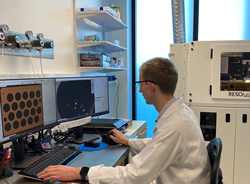 The Australian Federal Police (AFP) has put its world-class forensic capability on show this week to celebrate National Science Week (13-21 August).
The Australian Federal Police (AFP) has put its world-class forensic capability on show this week to celebrate National Science Week (13-21 August).
Marking the Week, Police said AFP Forensics comprised of a large number of specialist services and capabilities at its state-of-the-art forensics facility in Canberra and within its regional commands.
It said this year’s National Science Week theme was Glass: More than meets the eye, and celebrated the many roles glass played in people’s lives.
Forensic Chemist at AFP, Jo Bunford said glass was a common type of evidence found at crime scenes.
“Glass is common in the everyday world but can become important evidence when broken in the commission of crimes such as break-ins, hit and run, ram raids, vandalism and assaults,” Dr Bunford said.
“Types of glass that may be seen in forensic casework can include fragments from door and window panes, vehicle windows and windscreens, bottles and containers, and television and mobile phone screens,” she said.
“When a pane of glass is broken, much of it falls in the direction of the blow that causes it to break, however, a large number of small fragments can travel backwards towards the breaker of the glass and become lodged in hair and clothing, or on what was used to break the glass.”
Dr Bunford said glass fragments could be retained on clothing items, in hair and on the item used to break the glass for a number of hours after transfer.
She said it was this knowledge of glass transfer and persistence that a forensic scientist could utilise to assist investigators.
“The presence of freshly broken glass fragments on clothing, in hair and on items used to break glass can indicate a recent contact with broken glass enabling a timeframe to be implied for when the glass was broken,” the Chemist said.
“The known physical and chemical properties of glass can be used by the forensic scientist to compare fragments recovered from clothing and other items of interest to a known glass sample from a scene,” she said.
“For example, recovered fragments compared to a broken window can provide a connection between people and locations/objects,” Dr Bunford said.



